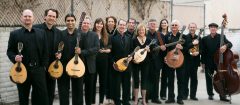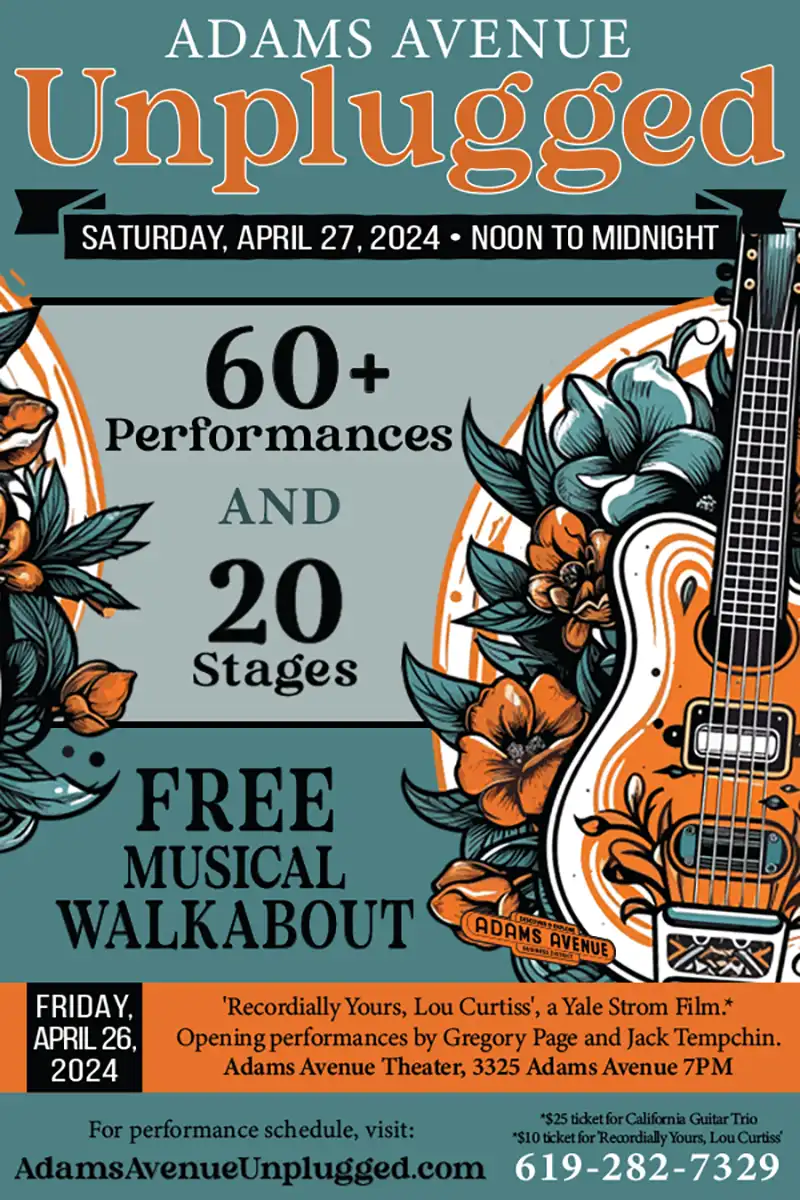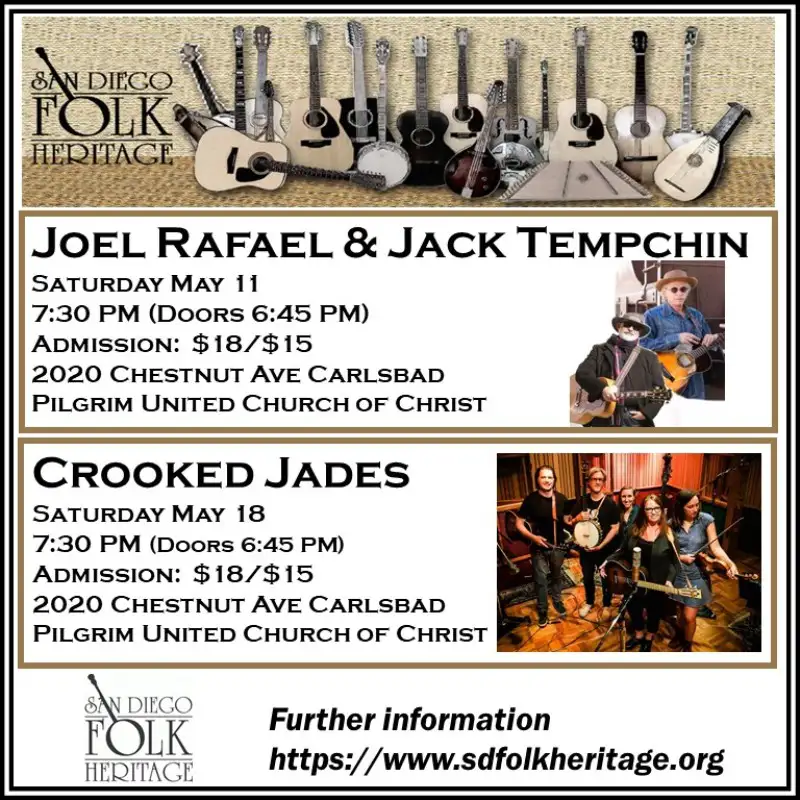Featured Stories
Latin-themed Concerts This Month from the New Expression Mandolin Orchestra

The New Expression Mandolin Orchestra with Chris Acquavella (far left)
“I love playing in this orchestra,” says Kara Ballester as she cradles her mandolin in her arms. “It’s a lot more interesting to play in a group than playing music by yourself. It’s a great experience.”
Ballester is a member of the New Expression Mandolin Orchestra, also known as NEMO, a 15-piece ensemble of mandolins that has been performing concerts and special occasions in the San Diego area for the last three years. On a warm Sunday in February, Ballester joined her fellow mandolinists for a rehearsal at New Expression Music in preparation for three performances this month.
Chris Aquavella leads the orchestra through several Latin-based compositions. Aquavella founded the orchestra three years ago at the bidding of his students. “A couple of my students were involved with the San Diego Mandolin Orchestra. They said that the music was too easy and wanted something more challenging,” he says. The recipient of several music awards, Aquavella is San Diego’s preeminent classical mandolinist. Besides teaching, he often performs programs of classical mandolin. He also performs with guitarist Nathan Jarrell as Duo LaRey, a project that mixes classical and jazz. Aquavella’s most recent recording, Praeludium, released in 2011, contains pieces for classical mandolin from the baroque period to the present.
The sun lies low in the sky and streams through the windows of the low-ceilinged practice room as the ensemble runs through the different compositions. Some of the musicians play round-backed mandolins, while others pluck the more modern types seen in bluegrass bands. There are a few of the somewhat larger mandolas, and two members play mandocellos, which are about the size of a standard guitar. There are also two guitarists, a string bassist, and a flutist.
The sound of the orchestra has a chiming, almost bell-like quality, with intricate timbres, what you might imagine from a room filled with mandolins. As each musician watches for cues and direction from Aquavella, they are also intent on the sheet music in front of them. At the close of the first number, one of the members asks, “What is going on at bar 56? Is this going short, short long?” Aquavella explains, “It’s bom bom la,” he sings in his baritone. There are more questions, as well as some quips and jokes. The atmosphere is friendly and relaxed.
Aquavella says that people are often surprised to find out that classical music is played on the mandolin. “There is a rich heritage of classical mandolin, but you wouldn’t know that in America,” he says. “After World War II, most of the classical mandolinists were from Europe, and that generation died off.” He also mentions that Bill Monroe, bluegrass music’s founding father, so forcefully associated the mandolin with his music that Americans to this day have a hard time thinking of the mandolin as anything but a bluegrass instrument.
A counselor and teacher at a secondary charter school, Ballester has been playing mandolin for about three years. “I played violin when I was a child, but stopped playing in college,” she says. “But I was out with friends for brunch at the Old Mission and we wandered in to Old Time Music. This is back when the shop was on University Avenue. I picked up a mandolin and found that it was tuned the same as a violin. A week later I came back and bought one.” She soon became one of Aquavella’s students and joined the orchestra.
Kevin Roberts, a sometimes luthier who builds guitars, works on all his mandolins, tweaking them here and there to suit his preferences. He took up the instrument several years ago and now owns four mandolins. A retiree, like a good number of the members of the ensemble, he had been playing country and bluegrass with his wife for few years when he attended a concert by NEMO during their first season. “I liked it so much I thought I’d like to join the orchestra. Chris said that he was taking people, and I’d already been learning to read music,” he says.
Like the other members, Roberts had to audition for his seat in the orchestra. He had to perform two pieces that he prepared for the audition, and he had to sight read a piece of music on the spot. “Chris is great instructor,” he says. “Even in the audition he taught me something. He showed me how to hold the mandolin. I’d been holding it off to my side, and he showed me to position the instrument to face the person across from me.”
Jim Trepasso plays the mandocello. He proudly holds his well-crafted but worn instrument. A 101-year-old associate who had played the mandocello for decades gave the instrument to Trepasso shortly before he passed away. A veteran of the army band and a retired music teacher, Trepasso had played trumpet for many years of his life. “But the mandocello doesn’t hurt my lip,” he jokes. He says he has gravitated toward and now appreciates the deeper, more resonant sounds of his baritone instrument.
“All my life I’ve wanted to play the mandolin,” says Bea North. “I started about five years ago after completing a five-and-a-half year voyage around the world. I told my husband that I wanted to play, and he bought me a mandolin.” Her first mandolin was a beginner’s model, but she has since upgraded to a hand-made design by the renowned mandolin luthier, Brian Dean, the same luthier who has produced mandolins used by Aquavella. “The other musicians in the orchestra are way over my level of performance, but playing with them gives me something to strive for. And Chris is such a wonderful teacher. He is so patient. A lot of teachers concentrate on your negatives, but he accents your positives. After each lesson I leave so inspired. And he’s so much fun!”
The structure of a mandolin orchestra is similar to a chamber or a string orchestra. “In general I will want three to four first and second mandolins and one or two mandocellos. You don’t want the lower register of the mandocellos to dominate the sound. It’s similar to a string orchestra, with the cellos not overtaking the ensemble,” says Aquavella.
Aquavella explains that, as the strings of the mandolins are plucked, a mandolin orchestra operates as though it were a large harp or piano. The arrangements for mandolin orchestra are thus often quite different from a string orchestra. Arrangements often break up notes and passages among the different sections, unlike string orchestra arrangements.
Although many mandolin orchestras perform arrangements of music from string orchestras, such as Tchaikovsky’s Nutcracker Suite, Aquavella prefers to perform pieces that have been written specifically for mandolin orchestra. All pieces for the upcoming concert are written for or specifically arranged for mandolin, except for a piece written by famed Argentine composer Astor Piazzolla, which was originally written for a small tango ensemble. Aquavella says that the program scheduled for the ninth of this month at the Normal Heights United Methodist Church may suit those folks who think of the mandolin as a folk instrument. The whole program is Latin-themed, with music from Spain, Brazil, Cuba, and other Latin countries.
The modern mandolin was developed in Naples, Italy, during the late eighteenth century. Their distinctive sound comes from double-course strings tuned in unison. If the mandolin has its Guarneri or Stradivarius, it is Luigi Embergher, who developed the mandola and the mandocello in the 1800s. The mandolin has the same register as the violin; the mandola corresponds to the viola; and the cello member of the mandolin family is the mandocello.
Mandolin orchestras go back to the late 1800s and reached the height of their popularity during the 1920s, both in Europe and in the United States. “One thing that you find, going back to this era, is the number of women who were in these orchestras. It was one place that they could be together and do something with men socially,” says Aquavella. “There were three things that were socially acceptable for women back then: bicycling, book clubs, and playing mandolins. They used to sell mandolins with little cases and shoulder straps. The intention was for the woman to sling the mandolin over her shoulder and bicycle off to her mandolin orchestra.” Mandolin orchestras remained popular on Europe, with most cities, and even some smaller towns, having an ensemble, or possibly several ensembles of mandolins
“This is so fulfilling for me,” says Aquavella. “With an orchestra, you take the musicians further than they might go if they were just playing at home. As a teacher, it’s great to see the smiles on the faces of the performers after a concert and the pleasure that they take in the music. Like a parent, its fun to watch them grow. This is a fantastic ensemble.”
See the New Expression Mandolin Orchestra in concert this month:
Saturday, March 9, Normal Heights United Methodist Church, 4650 Mansfield St., Normal Heights, 7pm.
Sunday, March 10, Lawrence Welk Resort, Champagne Village Hall, 8975 Champagne Blvd., Escondido, 1pm.







